Lexus LX450 2001, LX470 2001, LX570 2001 Owner Manual

SECTION 6 ± 1
SERVICE PROCEDURES AND
SPECIFICATIONS
Introduction
Vehicle identification . . . . . . . . . . . . . . . . . . . . . . . . . . . . . . . . . . . . . . 284 Engine compartment overview . . . . . . . . . . . . . . . . . . . . . . . . . . . . . 285 Do±it±yourself service precautions . . . . . . . . . . . . . . . . . . . . . . . . . 286 Parts and tools . . . . . . . . . . . . . . . . . . . . . . . . . . . . . . . . . . . . . . . . . . 287
283
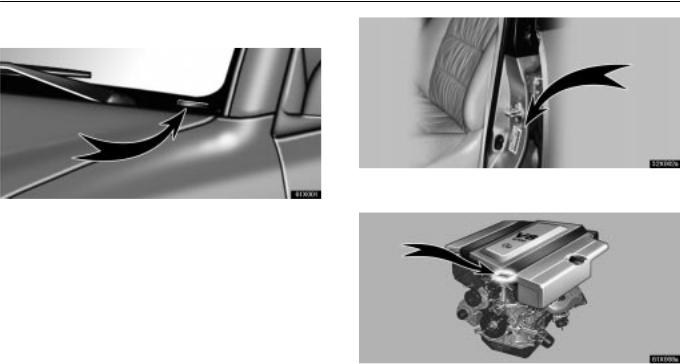
INTRODUCTION
VEHICLE IDENTIFICATION
The vehicle identification number (VIN) is the legal identifier for your vehicle. This number is on the left top of the instrument panel and can be seen through the windshield from outside.
This is the primary identification number for your Lexus. It is used in registering the ownership of your vehicle.
The vehicle identification number (VIN) is also on the Certification Label.
The engine number is stamped on the engine block as shown.
284
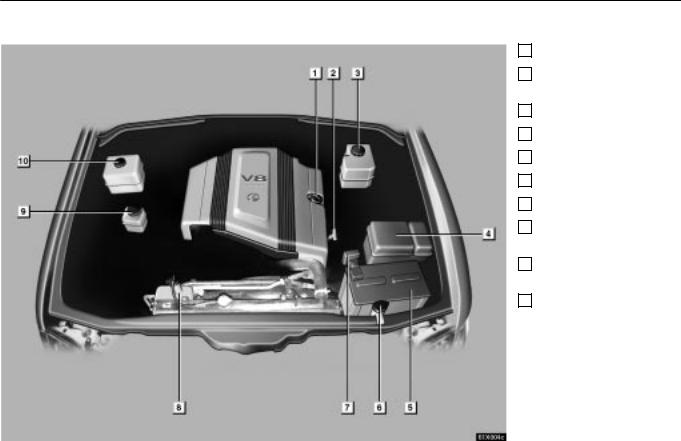
INTRODUCTION
ENGINE COMPARTMENT OVERVIEW
1 Engine oil filler cap
2 Engine oil level dipstick
3 Brake fluid reservoir
4 Fuse box
5 Battery
6 Washer fluid tank
7 Fuse box
8 Engine coolant reservoir
9 Power steering fluid reservoir
10 Suspension fluid reservoir
285
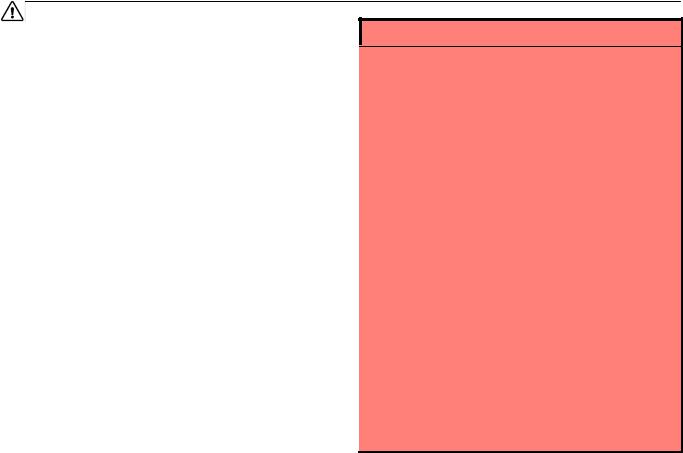
INTRODUCTION
DO±IT±YOURSELF SERVICE
PRECAUTIONS
If you perform maintenance yourself, be sure to follow the correct procedure given in this Section.
You should be aware that improper or incomplete servicing may result in operating problems.
Performing do±it±yourself maintenance during the warranty period may affect your warranty coverage. Read the separate Lexus Warranty statement for details and suggestions.
This Section gives instructions only for those items that are relatively easy for an owner to perform. As explained in Section 5, there are still a number of items that must be performed by a qualified technician with special tools.
For information on tools and parts for do±it±yourself maintenance, see ºParts and toolsº on page 287.
Utmost care should be taken when working on your vehicle to prevent accidental injury. Here are a few precautions that you should be especially careful to observe:
CAUTION
When the engine is running, keep hands, clothing, and tools away from the moving fan and engine drive belt. (Removing rings, watches, and ties is advisable.)
Right after driving, the engine compartment ± the engine, radiator, exhaust manifold and power steering fluid reservoir and spark plug boots, etc. ± will be hot. So be careful not to touch them. Oil, other fluids and spark plugs may also be hot.
If the engine is hot, do not remove the radiator cap or loosen the drain plugs to prevent burning yourself.
Do not smoke, cause sparks or allow open flames around fuel or the battery. Their fumes are flammable.
Do not get under your vehicle with just the body jack supporting it. Always use automotive jack stands or other solid supports.
Use eye protection whenever you work on or under your vehicle where you may be exposed to flying or falling material, fluid spray, etc.
Be extremely cautious when working on the battery. It contains poisonous and corrosive sulfuric acid.
Warning: Battery posts, terminals and related accessories contain lead and lead compounds, chemicals known to the State of California to cause cancer and reproductive harm. Wash hands after handling.
286
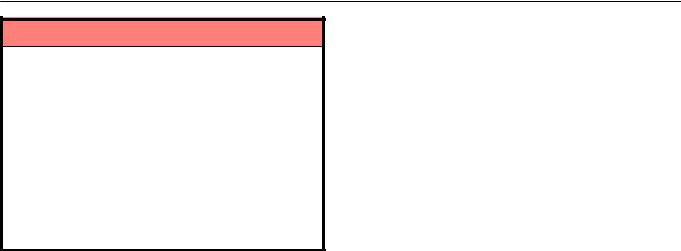
INTRODUCTION
NOTICE
Remember that battery and ignition cables carry high currents or voltages. Be careful of accidentally causing a short circuit.
Before closing the engine hood, check to see that you have not forgotten any tools, rags, etc.
Do not drive with the air cleaner removed, or excessive engine wear could result. Also backfiring could cause a fire in the engine compartment.
Do not overfill automatic transmission fluid, transfer oil and power steering fluid, or the transmission, transfer and power steering could be damaged.
Be careful not to scratch the glass surface with the wiper frame.
PARTS AND TOOLS
Here is a list of parts and tools you will need to perform do±it±yourself maintenance. Remember all Lexus parts are designed in metric sizes, so your tools must be metric.
Checking the engine oil level
Parts (if level is low):
Use API grade SJ, ºEnergy±Conservingº multigrade engine oil or ILSAC multigrade engine oil. For recommended oil viscosity, see page 297.
Tools:
Rag or paper towel
Funnel (only for adding oil)
Checking the engine coolant level
Parts (if level is low):
ªToyota Long Life Coolantº or equivalent
See ºChecking the engine coolant levelº on page 298 for instructions.
Demineralized or distilled water
Tools:
Funnel (only for adding coolant)
287

INTRODUCTION
Checking brake fluid
Parts (if level is low):
FMVSS No. 116 DOT 3 or SAE J1703 brake fluid
Tools:
Rag or paper towel
Funnel (only for adding fluid)
Checking power steering fluid
Parts (if level is low):
Automatic transmission fluid DEXRON II or III
Tools:
Rag or paper towel
Funnel (only for adding fluid)
Checking suspension fluid AHC
Parts (if level is low):
Suspension fluid AHC
Tools:
Rag or paper towel
Funnel (only for adding fluid)
Checking battery condition
Tools:
Warm water
Baking soda
Grease
Conventional wrench (for terminal clamp bolts)
Checking and replacing the blade type fuses
Parts (if replacement is necessary):
Fuse with same amperage rating as original
Checking the cartridge type fuses
Parts (if replacement is necessary):
Genuine Lexus fuse or equivalent with same amperage rating as original
Adding washer fluid
Parts:
Water
Washer fluid containing antifreeze (for winter use)
Tools:
Funnel
288

SECTION 7
REPORTING SAFETY DEFECTS FOR U.S. OWNERS
Reporting safety defects for U.S. owners . . . . . . . . . . . . . . . . . . . . 340
339

REPORTING SAFETY DEFECTS
REPORTING SAFETY DEFECTS
FOR U.S. OWNERS
If you believe that your vehicle has a defect which could cause a crash or could cause injury or death, you should immediately inform the National Highway Traffic Safety Administration (NHTSA) in addition to notifying Toyota Motor Sales, U.S.A., Inc. (Toll±free: 1±800±25±LEXUS).
If NHTSA receives similar complaints, it may open an investigation, and if it finds that a safety defect exists in a group of vehicles, it may order a recall and remedy campaign. However, NHTSA cannot become involved in individual problems between you, your dealer, or Toyota Motor Sales, U.S.A., Inc.
To contact NHTSA, you may either call the Auto Safety Hotline toll±free at 1±800±424±9393 (or 366±0123 in Washington, D.C. area) or write to: NHTSA, U.S. Department of Transportation, Washington, D.C. 20590. You can also obtain other information about motor vehicle safety from the Hotline.
340

SECTION 6 ± 5
SERVICE PROCEDURES AND
SPECIFICATIONS
Body
Specifications . . . . . . . . . . . . . . . . . . . . . . . . . . . . . . . . . . . . . . . . . . . 332 Protecting your vehicle from corrosion . . . . . . . . . . . . . . . . . . . . . . 333 Washing and waxing . . . . . . . . . . . . . . . . . . . . . . . . . . . . . . . . . . . . . 334 Cleaning the interior . . . . . . . . . . . . . . . . . . . . . . . . . . . . . . . . . . . . . . 336
331

BODY
SPECIFICATIONS
± DIMENSIONS AND WEIGHT
Overall length |
4890 mm (192.5 in.) |
Overall width |
1940 mm (76.4 in.) |
Overall height |
1850 mm (72.8 in.)* |
Wheelbase |
2850 mm (112.2 in.) |
Tread ± Front |
1620 mm (63.8 in.) |
± Rear |
1615 mm (63.6 in.) |
Vehicle capacity weight (occupants + luggage) |
562 kg (1240 lb.) |
|
|
*: Unladen vehicle |
|
± FUEL TANK |
|
|
|
Capacity |
96 L (25.4 gal., 21.1 lmp.gal.) |
|
|
332

BODY
PROTECTING YOUR VEHICLE
FROM CORROSION
Proper care of your Lexus can help ensure long±term corrosion prevention.
The most common causes of corrosion to your vehicle are:
The accumulation of road salt, dirt and moisture in hard±to±reach areas under the vehicle.
Chipping of paint or undercoating caused by minor accidents or by stones and gravel.
The following conditions will cause or accelerate corrosion of your vehicle, so it is important to keep your vehicle, particularly the underside, as clean as possible and to repair any damage to paint or protective coatings as soon as possible.
The presence of road salt or dust control chemicals, salt in the air near the sea coast, industrial air pollution.
High humidity, especially at temperatures just above freezing point.
Certain parts of your vehicle are wet or damp for an extended period of time, even though other parts of the vehicle are dry.
Components of the vehicle which are prevented from quick±drying due to lack of proper ventilation are exposed to high ambient temperature.
To help prevent corrosion on your Lexus, follow these guidelines:
Keep your vehicle clean by regular washing. In addition, observe the following points.
If you drive on salted roads in the winter or if you live near the ocean, you should hose off the undercarriage at least once a month to minimize corrosion.
High pressure water or steam is effective for cleaning the vehicle's underside and wheel housings. Pay particular attention to these areas as it is difficult to see all the mud and dirt. It will do more harm than good to simply wet the mud and debris without removing them. The lower edge of doors, rocker panels and frame members have drain holes which should not be allowed to clog with dirt as trapped water in these areas can cause corrosion.
Wash the underside of the vehicle thoroughly when winter is over.
See ºWashing and waxingº on page 334 for more tips.
Check the condition of your vehicle's paint and trim. If you find any chips or scratches in the paint, touch them up immediately to prevent corrosion from starting. If the chips or scratches have gone through the bare metal, have a qualified body shop make the repair.
333

BODY
Check the interior of your vehicle. Water and dirt can accumulate under the floor mats and could cause corrosion. Occasionally check under the mats to make sure the area is dry. Be particularly careful when transporting chemicals, cleansers, fertilizers, salt, etc. These should be transported in proper containers. If a spill or leak should occur, immediately clean and dry the area.
Use mud shields on your wheels. If you drive on salted or gravel roads, mud shields help protect your vehicle. Full±size shields, which come as near to the ground as possible, are the best. We recommend that the fittings and the area where the shields are installed be treated to resist corrosion. Your Lexus dealer will be happy to assist in supplying and installing the shields if they are recommended for your area.
Keep your vehicle in a well ventilated garage or a roofed place. Do not park your vehicle in a damp, poorly ventilated garage. If you wash your vehicle in the garage, or if you drive it in covered with water or snow, your garage may be so damp it will cause corrosion. Even if your garage is heated, a wet vehicle can corrode if the ventilation is poor.
WASHING AND WAXING
Washing your Lexus
Keep your vehicle clean by regular washing.
The following cases may cause weakness to the paint or corrosion to the body and parts. Wash your vehicle as soon as possible.
When driving in a coastal area
When driving on a road sprinkled with antifreeze
When having coal tar, tree sap, bird droppings and carcass of an insect
When driving in the areas where there is a lot of smoke, soot, dust, iron dust and chemical substance
When the vehicle becomes remarkably dirty with dust and mud
Hand±washing your Lexus
Work in the shade and wait until the vehicle body is not hot to the touch.
1.Rinse off loose dirt with a hose. Remove any mud or road salt from the underside of the vehicle or in the wheel wells.
2.Wash with a mild car±wash soap, mixed according to the manufacturer's instructions. Use a soft cotton mitt and keep it wet by dipping it frequently into the wash water. Do not rub hard ± let the soap and water remove the dirt.
334
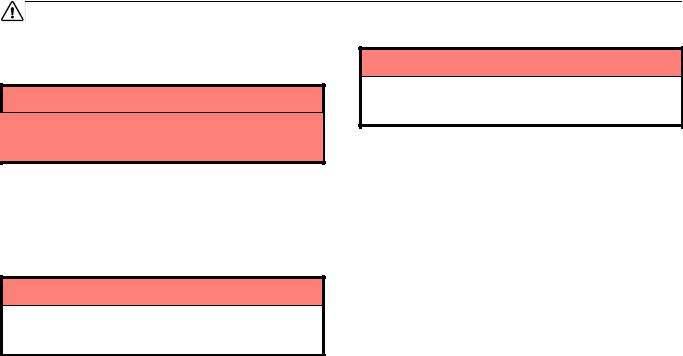
BODY
Plastic wheel ornaments: The plastic wheel ornaments are damaged easily by organic substances. If any organic substance splashes an ornament, be sure to wash it off with water and check if the ornament is damaged.
CAUTION
Do not attach the heavily damaged plastic wheel ornament. It may fly off the wheel and cause accidents while the vehicle is moving.
Aluminum wheels: Use only a mild soap or neutral detergent.
Urethane bumpers and side moldings: Wash carefully. Do not scrub with abrasive cleaners. The bumper and side molding faces are soft.
Road tar: Remove with turpentine or cleaners that are marked safe for painted surfaces.
NOTICE
Do not use organic substances (gasoline, kerosene, benzine or strong solvents), which may be toxic or cause damage.
3.Rinse thoroughly ± dried soap can cause streaking. In hot weather you may need to rinse each section right after you wash it.
4.To prevent water spots, dry the vehicle using a clean soft cotton towel. Do not rub or press hard ± you might scratch the paint.
Automatic car wash
NOTICE
To prevent damage to the antenna, make sure it is retracted before driving your vehicle through an automatic car wash.
Your vehicle may be washed in an automatic car wash, but remember that the paint can be scratched by some type of brushes, unfiltered washing water, or the washing process itself. Scratching reduces paint durability and gloss, especially on darker colors. The manager of the car wash should be able to advise you whether the process is safe for the paint on your vehicle.
Waxing your Lexus
Polishing and waxing is recommended to maintain the original beauty of your Lexus' finish.
Once a month or if the vehicle surface does not repel water well, apply wax.
1.Always wash and dry the vehicle before you begin waxing, even if you are using a combined cleaner and wax.
2.Use a good quality polish and wax. If the finish has become extremely weathered, use a car±cleaning polish, followed by a separate wax. Carefully follow the manufacturer's instructions and precautions. Be sure to polish and wax the chrome trim as well as the paint.
335
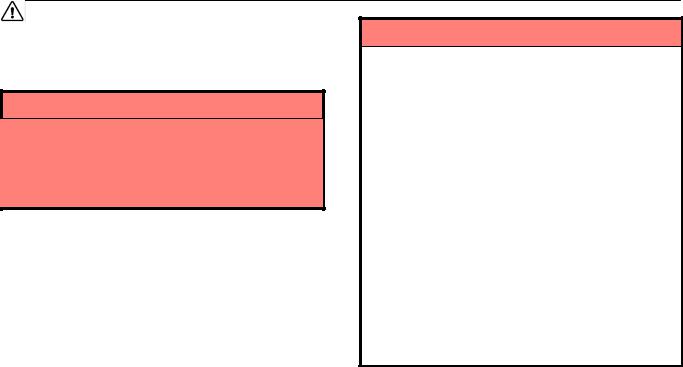
BODY
3. Wax the vehicle again when water does not bead but remains on the surface in large patches.
CLEANING THE INTERIOR
CAUTION
Do not wash the vehicle floor with water, or allow water to get onto the floor when cleaning the vehicle interior or exterior. Water may get into audio components or other electrical components above or under the floor carpet (or mat) and cause a malfunction; and it may cause body corrosion.
Leather Interior
Remove dirt using a soft cloth dampened with 5 % solution of neutral detergent for wool. Then thoroughly wipe off all traces of detergent with a clean damp cloth.
After cleaning or whenever any part of the leather gets wet, dry with a soft clean cloth. Allow the leather to dry in a ventilated shaded area.
NOTICE
If a stain should fail to come out with a neutral detergent, apply a cleaner that does not contain an organic solvent.
Never use organic substances such as benzine, alcohol or gasoline, or alkaline or acid solutions for cleaning the leather as these could cause discoloring.
Use of a nylon brush or synthetic fiber cloth, etc. may scratch the fine grained surface of the leather.
Mildew may develop on soiled leather upholstery. Be especially careful to avoid oil spots. Try to keep your upholstery always clean.
Long exposure to direct sunlight may cause the leather surface to harden and shrink. Keep your vehicle in a shaded area, especially in the summer.
The interior of your vehicle is apt to heat up on hot summer days, so avoid placing on the upholstery items made of vinyl or plastic or containing wax as these tend to stick to leather when warm.
Improper cleaning of the leather upholstery could result in discoloration or staining.
336
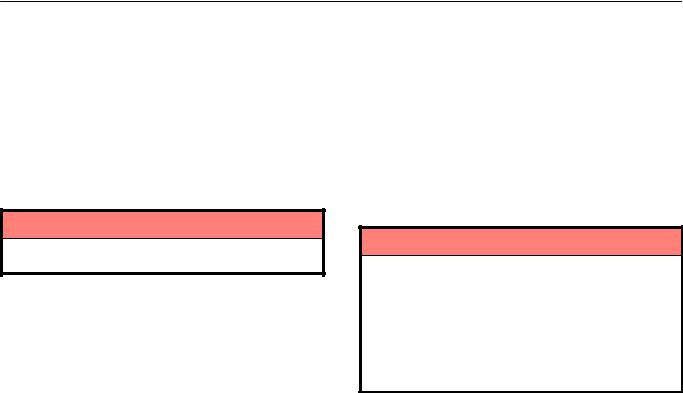
BODY
Synthetic Leather Areas (Part of door panels)
The synthetic leather areas may be easily cleaned with a mild soap or detergent and water.
First vacuum over the upholstery to remove loose dirt. Then, using a sponge or soft cloth, apply the soap solution to the synthetic leather. After allowing it to soak in for a few minutes to loosen the dirt, remove the dirt and wipe off the soap with a clean damp cloth. If all the dirt does not come off, repeat the procedure. Commercial foaming±type cleaners are also available which work well. Follow the manufacturer's instructions.
NOTICE
Do not use solvent, thinner, gasoline or window cleaner on the interior.
Carpets, Windows and Seat Belts
Begin by vacuuming thoroughly to remove as much dirt as possible. Several types of foam cleaners are available; some are in aerosol cans and others are powders or liquids which you mix with water to produce a foam. To shampoo the carpets, use a sponge or brush to apply the foam. Rub in overlapping circles. Do not apply water ± the best results are obtained by keeping the carpet as dry as possible. Read the shampoo instructions and follow them closely.
The seat belts may be cleaned with mild soap and water or with lukewarm water.
Use a cloth or sponge. As you are cleaning, check the belts for excessive wear, fraying or cuts.
NOTICE
Use a good foam±type shampoo to clean the carpets.
Do not use dye or bleach on the belts ± it may weaken them.
Do not use the belts until they become dry.
The windows may be cleaned with any household window cleaner.
When cleaning the inside of the rear window, be careful not to scratch or damage the heater wires.
337
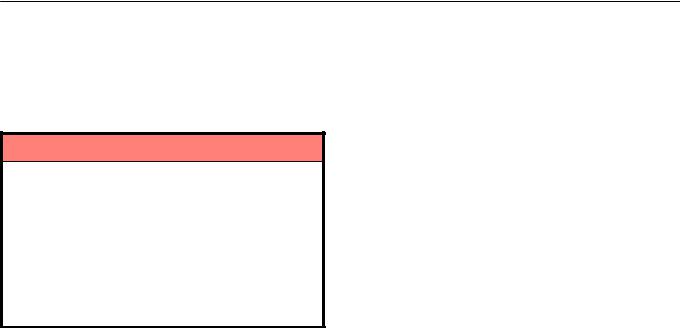
BODY
Air Conditioning Control Panel, Car Audio,
Instrument Panel, Console Panel, and
Switches
Use a soft damp cloth for cleaning.
Soak a clean soft cloth in water or lukewarm water then lightly wipe off any dirt.
NOTICE
Do not use organic substances (solvents, kerosene, alcohol, gasoline, etc.) or alkaline or acidic solutions. These chemicals can cause discoloring, staining or peeling of the surface.
If you use cleaners or polishing agents, make sure their ingredients do not include the substances mentioned above.
If you use a liquid car freshener, do not spill the liquid onto the vehicle's interior surfaces. It may contain the ingredients mentioned above. Immediately clean any spill using the method mentioned above.
If you have any questions about the cleaning of your Lexus, your local Lexus dealer will be pleased to answer them.
338

SECTION 6 ± 3
SERVICE PROCEDURES AND
SPECIFICATIONS
Chassis
Specifications . . . . . . . . . . . . . . . . . . . . . . . . . . . . . . . . . . . . . . . . . . . 302 Checking brake fluid . . . . . . . . . . . . . . . . . . . . . . . . . . . . . . . . . . . . . . 305 Checking power steering fluid . . . . . . . . . . . . . . . . . . . . . . . . . . . . . 306 Checking suspension fluid AHC . . . . . . . . . . . . . . . . . . . . . . . . . . . . 307 Checking tire pressure . . . . . . . . . . . . . . . . . . . . . . . . . . . . . . . . . . . . 308 Rotating tires . . . . . . . . . . . . . . . . . . . . . . . . . . . . . . . . . . . . . . . . . . . . 309 Checking and replacing tires . . . . . . . . . . . . . . . . . . . . . . . . . . . . . . 309 Installing snow tires and chains . . . . . . . . . . . . . . . . . . . . . . . . . . . . 312 Replacing wheels . . . . . . . . . . . . . . . . . . . . . . . . . . . . . . . . . . . . . . . . 313 Aluminum wheel precautions . . . . . . . . . . . . . . . . . . . . . . . . . . . . . . 314 Suspension and chassis . . . . . . . . . . . . . . . . . . . . . . . . . . . . . . . . . . 314
301

CHASSIS
SPECIFICATIONS
± TRANSFER
Oil capacity |
1.3 L (1.4 qt., 1.1 lmp.qt.) |
Oil type |
Gear oil API GL±4 or GL±5 |
Recommended oil viscosity |
SAE 75W±90 |
|
|
± AUTOMATIC TRANSMISSION |
|
|
|
Fluid capacity |
|
Drain and refill |
Up to 2.0 L (2.1 qt., 1.8 lmp.qt.) |
Fluid type |
Automatic transmission fluid D±II or DEXRON III |
|
(DEXRON II) |
± DIFFERENTIAL |
|
|
|
Oil capacity |
|
Front |
1.6 L (1.7 qt., 1.4 lmp.qt.) |
Rear |
3.3 L (3.5 qt., 2.9 lmp.qt.) |
Oil type |
Hypoid gear oil API GL±5 |
Oil viscosity |
Above ±18 C (0 F): SAE 90 |
|
Below ±18 C (0 F): SAE 80W or SAE 80W±90 |
|
|
302

CHASSIS
± BRAKES
Pedal clearance |
116 mm (4.57 in.) Min. *1 |
Pedal free play |
1 ± 6 mm (0.04 ± 0.24 in.) |
Brake pad wear limit |
1.0 mm (0.04 in.) |
Parking brake lining wear limit |
1.0 mm (0.04 in.) |
Parking brake adjustment |
4 ± 6 clicks *2 |
Fluid type |
SAE J1703 or FMVSS No. 116 DOT 3 |
|
|
*1: Minimum pedal clearance when depressed with the force of 490 N (50 kgf, 110 lbf.) with the engine running *2: Parking brake adjustment when pulled with the force of 196 N (20 kgf, 44 lbf.)
± CHASSIS LUBRICATION
Wheel bearings |
Lithium base wheel bearing grease, NLGI No.2 |
Steering knuckles |
Molybdenum±disulfide lithium base chassis grease, NLGI No.2 |
Propeller shafts |
Lithium base wheel bearing grease, NLGI No.2 |
|
|
± STEERING |
|
|
|
Free play |
Less than 40 mm (1.6 in.) |
Power steering fluid |
Automatic transmission fluid DEXRON II or III |
± SUSPENSION |
|
|
|
Fluid type |
Suspension fluid AHC |
|
|
303

CHASSIS
± TIRES AND WHEELS
Tire size |
P275/70R16 114S |
|
|
Tire inflation pressure |
|
|
|
Recommended cold tire inflation pressure |
|
|
|
Vehicle load up to four occupants |
Front |
200 kPa (2.0 kgf/cm2 or bar, 29 psi) |
|
|
Rear |
220 kPa (2.2 kgf/cm2 or bar, 32 psi) |
|
Vehicle loaded up to vehicle capacity weight |
Front |
200 kPa (2.0 kgf/cm2 |
or bar, 29 psi) |
|
Rear |
220 kPa (2.2 kgf/cm2 |
or bar, 32 psi) |
Wheel size |
16 x 8 JJ |
|
|
Wheel nut torque |
131 N´m (13.4 kgf´m, 97 ft´lbf.) |
||
|
|
|
|
NOTE: For complete information on tires (e.g. replacing tires or replacing wheels), see ªChecking tire pressureº through ªAluminum wheel precautionsº on page 308 through 314.
304
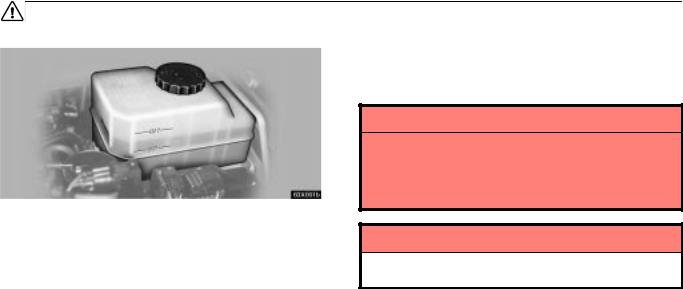
CHASSIS
CHECKING BRAKE FLUID
To check the fluid level, simply look at the see±through reservoir. The level should be between the ºMAXº and ºMINº lines on the tank.
It is normal for the brake fluid level to go down slightly as the brake pads wear or when the fluid level in the accumulator is high.
If the reservoir needs frequent refilling, it may indicate a serious mechanical problem.
If the level is low, add FMVSS No.116 DOT 3 or SAE J1703 brake fluid to the brake reservoir.
Refilling brake fluid:
1.Turn the ignition switch off.
2.Depress the brake pedal more than 40 times.
3.Remove the reservoir cap by hand. Add brake fluid up to the ºMAXº line.
If you do not follow the procedure above, the reservoir may overflow.
Use only newly opened brake fluid. Once opened, brake fluid absorbs moisture from the air, and excess moisture can cause a dangerous loss of braking efficiency.
CAUTION
Take care when filling the reservoir because brake fluid can harm your hands or eyes and damage painted surfaces. If fluid gets in your eyes, flush them with clean water immediately. If you still feel uncomfortable with your eyes, go to the doctor.
NOTICE
If you spill some of the fluid, be sure to wipe it off to prevent it from damaging the parts or paintwork.
305
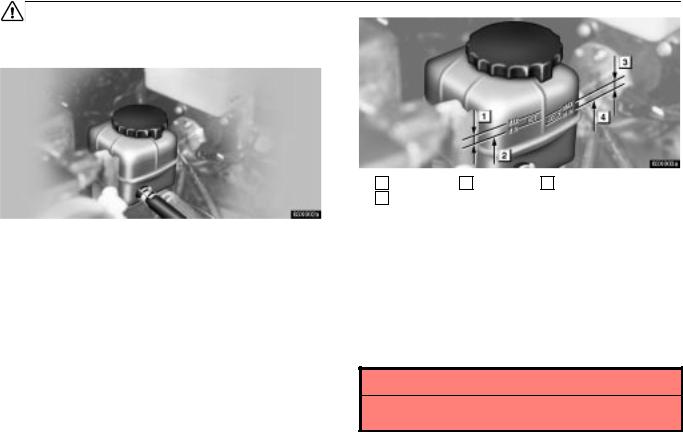
CHASSIS
CHECKING POWER STEERING
FLUID
Check the fluid level on the dipstick. If necessary, add automatic transmission fluid DEXRON II or III.
If the vehicle has been driven around 80 km/h (50 mph) for 20 minutes (a little more in frigid temperatures), the fluid is hot (60 C ± 80 C or 140 F ± 175 F). You may also check the level when the fluid is cold (about room temperature, 10 C ± 30 C or 50 F ± 85 F) if the engine has not been run for about five hours.
1 If hot O.K. 2 If hot add 3 If cold O.K.
4 If cold add
Clean all dirt off the reservoir and look at the fluid level. If the fluid is cold, the level should be in the ºCOLDº range. Similarly, if it is hot, the fluid level should be in the ºHOTº range. If the level is at the low side of the appropriate range, add automatic transmission fluid DEXRON II or III to bring the level within the range.
To remove the reservoir cap, turn it counterclockwise and lift up. To reinstall it, turn it clockwise. After replacing the reservoir cap, visually check the steering box case, vane pump and hose connections for leaks or damage.
CAUTION
The reservoir may be hot so be careful not to burn yourself.
306
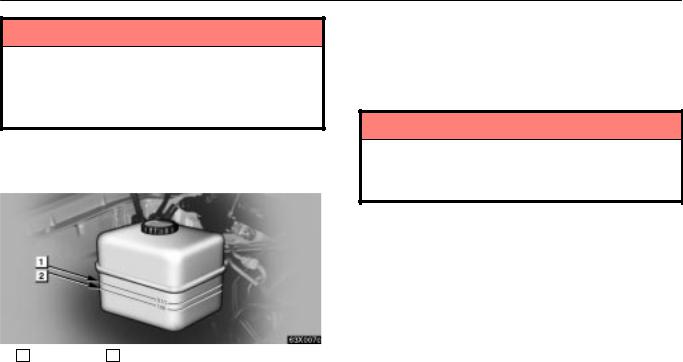
CHASSIS
NOTICE
Avoid overfilling, or the power steering could be damaged.
When adding the power steering fluid, avoid spilling it. The generator under the power steering reservoir could be damaged if fluid is spilled on it.
CHECKING SUSPENSION FLUID
AHC
2.Turn off the ignition switch about 30 seconds after the ºNº (Normal) mode indicator light comes on.
3.Make sure the fluid level is between ºMAXº and ºMINº.
If the fluid level is lower than ºMINº, have suspension fluid AHC filled by your Lexus dealer.
NOTICE
Only use the Suspension fluid AHC for the active height control suspension. If you fill other fluids such as brake fluid, power steering fluid, engine oil, etc., the active height control suspension could be damaged.
1 ºMAXº line 2 ºMINº line
Under the unloaded condition, check the Suspension Fluid AHC in the following way.
1. Start the engine and put the vehicle height in the ºLOº (Low) mode and then ºNº (Normal) mode.
307

CHASSIS
CHECKING TIRE PRESSURE
The recommended cold tire pressures, tire size and the vehicle capacity weight are given on the label.
You should check the tire pressures every two weeks, or at least once a month. And don't forget the spare! The pressure for the spare tire should be 220 kPa (2.2 kgf/cm2 or bar, 32 psi). Incorrect tire pressure can reduce tire life and make your vehicle less safe to drive.
Low tire pressure results in excessive wear, poor handling, reduced fuel economy, and the possibility of blowouts from overheated tires. Also, low tire pressure can cause poor sealing of the tire bead. If the tire pressure is excessively low, there is the possibility of wheel deformation and/or tire separation. So keep your tire pressures at the proper level. If a tire needs frequent refilling, have it checked by your Lexus dealer.
High tire pressure produces a harsh ride, handling problems, excessive wear at the center of the tire tread, and a greater possibility of tire damage from road hazards.
The following instructions for checking tire pressure should be observed:
The pressure should be checked only when the tires are cold. If your vehicle has been parked for at least 3 hours and has not been driven for more than 1.5 km or 1 mile since, you will get an accurate cold tire pressure reading.
Always use a tire pressure gauge. The appearance of the tire can be misleading. Besides, tire pressures that are even just a few pounds off can degrade ride and handling.
Do not bleed or reduce tire pressure after driving. It is normal for the tire pressure to be higher after driving.
Never exceed the vehicle capacity weight. The passengers and luggage weight should be located so that the vehicle is balanced.
Be sure to reinstall the tire valve caps. Without the valve caps, dirt or moisture could get into the valve core and cause air leakage. If the caps have been lost, have new ones put on as soon as possible.
308

|
|
|
|
|
CHASSIS |
|
ROTATING TIRES |
CHECKING AND REPLACING TIRES |
|||
|
|
|
When to replace your tires |
||
|
|
|
|
|
|
|
|
|
|
|
|
|
|
|
|
|
|
|
|
|
|
|
|
To equalize tire wear and help extend tire life, Lexus recommends that you rotate your tires according to the maintenance schedule. (For scheduled maintenance information, please refer to the ªOwner 's Manual Supplementº or ªMaintenance Scheduleº.) However, the most appropriate timing for tire rotation may vary according to your driving habits and road surface conditions.
The wheel assemblies must be rotated as illustrated above.
When rotating tires, check for uneven wear and damage. Abnormal wear is usually caused by incorrect tire pressure, improper wheel alignment, out±of balance wheels, or severe braking.
Before storing radial, snow or studded tires, mark the direction of rotation and be sure to install them in the same direction when using them again. Tires should be stored in a cool dry place.
1 New tread 2 Tread wear indicator
3 Worn tread
Replace the tires when the tread wear indicators show. The location of the tread wear indicators is shown by the marks molded on the sidewall of each tire.
The tires on your Lexus have built±in tread wear indicators to help you know when the tires need replacement. When the tread depth wears to 1.6 mm (0.06 in.) or less, the indicators will appear. If you can see the indicators in two or more adjacent grooves, the tire should be replaced.
The effectiveness of snow tires is lost if the tread wears down below 4 mm (0.16 in.).
309

CHASSIS
If you have tire damage such as cuts, splits, cracks deep enough to expose the fabric, or bulges indicating internal damage, the tire should be replaced.
If a tire often goes flat or cannot be properly repaired due to the size or location of a cut or other damage, it should be replaced. If you are not sure, consult with your Lexus dealer.
If an air loss occurs while driving, do not continue driving with a deflated tire. Driving even a short distance can damage a tire beyond repair.
Any tires which are over 6 years old must be checked by a qualified technician even if damage is not obvious.
Tires deteriorate with age even if they have never or seldom been used.
This also applies to the spare tire and tires stored for future use.
Uniform tire quality grading
This information has been prepared in accordance with regulations issued by the National Highway Traffic Safety Administration of the U.S. Department of Transportation. It provides the purchasers and/or prospective purchasers of Lexus vehicles with information on uniform tire quality grading.
Your Lexus dealer will help answer any questions you may have as you read this information.
DOT quality grades ± All passenger vehicle tires must conform to Federal Safety Requirements in addition to these grades. Quality grades can be found where applicable on the tire sidewall between tread shoulder and maximum section width. For example: Treadwear 200 Traction AA Temperature A
Treadwear ± The treadwear grade is a comparative rating based on the wear rate of the tire when tested under controlled conditions on a specified government test course. For example, a tire graded 150 would wear one and a half (1 ± 1/2) times as well on the government course as a tire graded 100. The relative performance of tires depends upon the actual conditions of their use, however, and may depart significantly from the norm due to variations in driving habits, service practices and differences in road characteristics and climate.
Traction AA, A, B, C ± The traction grades, from highest to lowest, are AA, A, B and C, and they represent the tire's ability to stop on wet pavement as measured under controlled conditions on specified government test surfaces of asphalt and concrete. A tire marked C may have poor traction performance.
310

CHASSIS
Warning: The traction grade assigned to this tire is based on braking (straight ahead) traction tests and does not include cornering (turning) traction.
Temperature A, B, C ± The temperature grades are A (the highest), B, and C, representing the tire's resistance to the generation of heat and its ability to dissipate heat when tested under controlled conditions on a specified indoor laboratory test wheel. Sustained high temperature can cause the material of the tire to degenerate and reduce tire life, and excessive temperature can lead to sudden tire failure. The grade C corresponds to a level of performance which all passenger car tires must meet under the Federal Motor Vehicle Safety Standard No. 109. Grades B and A represent higher levels of performance on the laboratory test wheel than the minimum required by law.
Warning: The temperature grades for this tire are established for a tire that is properly inflated and not overloaded. Excessive speed, underinflation, or excessive loading, either separately or in combination, can cause heat buildup and possible tire failure.
Tire selection
When replacing a tire, use only the same size and construction as originally installed and with the same or greater load capacity.
Using any other size or type of tire may seriously affect handling, ride, speedometer/odometer calibration, ground clearance, and clearance between the body and tires or snow chains.
Do not mix radial, belted, or conventional tires on your vehicle.
Do not use tires or wheels other than the manufacturer's recommended size.
It can cause dangerous handling characteristics, resulting in loss of control. If you need to change from conventional tires to radial tires or vice versa, replace them as a set.
311
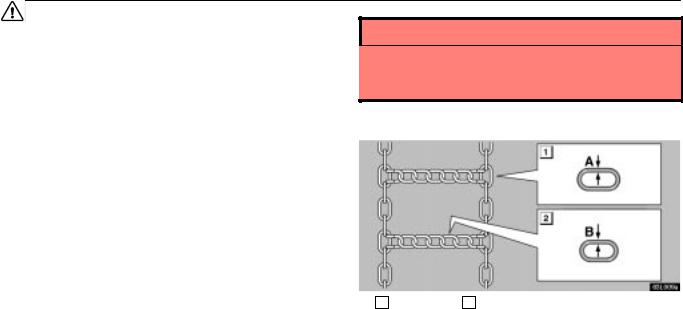
CHASSIS
INSTALLING SNOW TIRES AND
CHAINS
When to use snow tires or chains
Snow tires or chains are recommended when driving on snow or ice.
On wet or dry roads, conventional or radial tires provide better traction than snow or studded tires.
Snow tire selection
If you need snow tires, select the same size, construction and load capacity as the original tires on your Lexus.
Do not use tires other than stated above. Since your vehicle has radial tires as original equipment, make sure your snow tires also have radial construction. Do not install studded tires without first checking local regulations for possible restrictions.
Snow tire installation
Snow tires should be installed on all wheels.
Installing snow tires on the rear wheels only can lead to an excessive difference in road grip capability between the front and rear tires which could cause loss of vehicle control.
CAUTION
Do not drive with the snow tires incorrectly inflated.
Never drive over 105 km/h (65 mph) with any type of snow tires.
Tire chain selection
1 Side chain 2 Cross chain
Use the tire chains of correct size.
For 275/70R16 tires, use the following type chains.
|
|
mm |
(in.) |
A: |
Diameter of side chain |
3.5 |
(0.14) |
B: |
Diameter of cross chain |
4.0 |
(0.16) |
Regulations regarding the use of tire chains vary according to location or type of road. Always check the local regulations before installing chains.
312
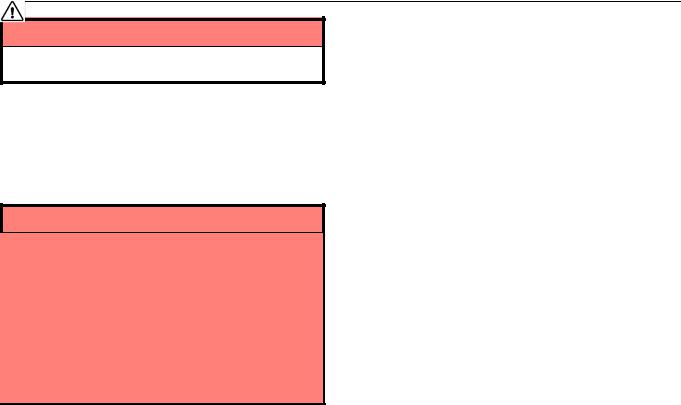
CHASSIS
NOTICE
If the wrong combination of tire and chain is used, the chains could damage the vehicle body.
Chain installation
Install the chains on the rear tires as tightly as possible. Do not use tire chains on the front tires. Retighten chains after driving 0.5 ± 1.0 km (1/4 ± 1/2 mile).
When installing chains on your tires, carefully follow the instructions of the chain manufacturer.
CAUTION
Do not exceed 50 km/h (30 mph) or the chain manufacturer's recommended speed limit, whichever is lower.
Drive carefully avoiding bumps, holes, and sharp turns, which may cause the vehicle to bounce.
Avoid sharp turns or locked±wheel braking, as use of chains may adversely affect vehicle handling.
When driving with chains installed, be sure to drive carefully. Slow down before entering the curves to avoid losing control of the vehicle. Otherwise an accident may occur.
REPLACING WHEELS
When to replace your wheels
If you have wheel damage such as bending, cracks or heavy corrosion, the wheel should be replaced.
If you fail to replace damaged wheels, the tire may slip off the wheel or cause loss of handling control.
Replacement with used wheels is not recommended as they may have been subjected to rough treatment or high mileage and could fail without warning. Also, bent wheels which have been straightened may have hidden structural damage and therefore should not be used. Never use an inner tube in a leaking wheel which is designed for a tubeless tire.
Wheel selection
When replacing wheels, care should be taken to ensure that they are equivalent to those removed in load capacity, diameter, rim width, and offset.
Correct replacement wheels are available at your Lexus dealer.
A wheel of a different size or type may adversely affect handling, wheel and bearing life, brake cooling, speedometer/odometer calibration, stopping ability, headlight aim, bumper height, vehicle ground clearance, and tire or snow chain clearance to the body and chassis.
313
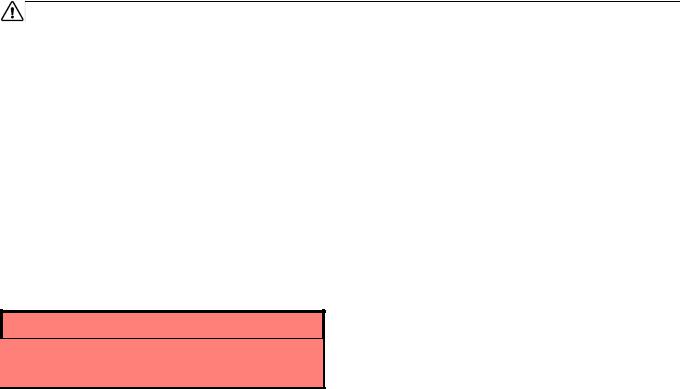
CHASSIS
ALUMINUM WHEEL PRECAUTIONS
When installing aluminum wheels, check that the wheel nuts are tight after driving your vehicle the first 1600 km (1000 miles).
If you have rotated, repaired, or changed your tires, check that the wheel nuts are still tight after driving 1600 km (1000 miles).
When using tire chains, be careful not to damage the aluminum wheels.
Use only the Lexus wheel nuts and wrench designed for your aluminum wheels.
When balancing your wheels, use only Lexus balance weights or equivalent and a plastic or rubber hammer.
As with any wheel, periodically check your aluminum wheels for damage. If damaged, replace immediately.
SUSPENSION AND CHASSIS
CAUTION
Do not modify the suspension/chassis with lift kits, spacers, springs, etc. It can cause dangerous handling characteristics, resulting in loss of control.
314
